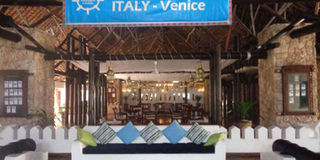Breaking News: At least 10 feared to have drowned in Makueni river
A different kind of cruise

The reception where passengers wait to board MV Voyager in Mombasa. PHOTO| RUPI MANGAT
What you need to know:
To entice people into the sea, Buccaneer offers a free dive lesson in the pool on the upper deck of the ‘ship’. It’s an amazing experience to see all that colour and shapes in the sea.
Dining in the main restaurant, the food stations capture life under the sea with cabinets of octopus, colourful reef fish and starfish in enameled cast while swordfish leap out of the blue sea in glass.
The officer on deck blows the bugle as passengers arrive on board MV Voyager docked at the port-of-call in Mombasa on the sunny shores of the Indian Ocean. It feels great to be walking up the gangplank to board the cruise – even if it’s just a different kind of cruise.
This is no ordinary cruise because it takes place on land and the vessel doesn’t move. The ship is the ship-themed Voyager Beach Resort. Fashioned as a merchandise vessel, crates of Kenya’s famous tea and coffee sacks are stacked up on board as décor pieces. Compasses and sailor wheels are on deck to steer the vessel and once you check in, it’s off to sea.
Passengers are encouraged to use the language of the seas when on board or else risk being forced to ‘walk the plank’ – an expression from the seafaring days when pirates and mutineers were forced to walk to the edge and fall into the sea.
It’s a beautiful day at sea with the tide at an ebb making it perfect for a reef encounter. Wearing a snorkel, I hop into the ocean’s warm waters where luminous fairy-tale fish swim in the coral.
AMAZING DIVES
Colourful starfish stick to the sandy bottom of the ocean floor while flashes of iridescent blues and green and stripes of black and white zebra fish swim around me. The trick to attract the fish is to stay as still as possible. Flapping around wards off the fish.
“We have amazing dives beyond the reef,” says the dive master at Buccaneer Diving.
He continues, “A few months ago, we were diving when a huge shadow came over us. Looking up, it was a whale shark. I was awestruck.”
The whale shark is the world’s largest fish.
To entice people into the sea, Buccaneer offers a free dive lesson in the pool on the upper deck of the ‘ship’. It’s an amazing experience to see all that colour and shapes in the sea.
Dining in the main restaurant, the food stations capture life under the sea with cabinets of octopus, colourful reef fish and starfish in enameled cast while swordfish leap out of the blue sea in glass.
“We call at various ports of call and every night there’s a different cuisine depending on where we are docked,” says Margaret Masha, the cabin crew, as I relish the coastal mandazi and mahamri washed down with coconut juice from the shell. “It breaks the monotony of the menu,” she adds.
This is in reference to the various cuisines served at the hotel on different nights. The previous day, the ‘ship’ was in India with Bombay curry and Bollywood entertainment under the stars.
PASTA AND PIZZA
Tonight, we are on the high seas and tomorrow the ‘ship’ will dock in Venice. Unquestionably, there will be a heavy dose of pasta and pizza and a cabaret performance by local dancers.
All this gets me thinking about an actual cruise ship. The biggest luxury cruise ship to-date is the Oasis of the Seas – it operates a one-of-a-kind aqua theatre at sea, has 25 dining options and a crew
of more than 2,000 to serve you like royalty. Back to my ‘cruise’, I walk into the natural cove for fine-dining. The upper deck lounge is the Swahili Lounge with the signature wooden carved beds and colourful kikois with the sky and the sea spread beyond.
And just like at sea where the cabins face the blue ocean, I’m by the seafront cabin where the sea resounds with the roar of the tide coming in and then just as quietly, calms down.
The cruise ‘docks’ in Mombasa where passengers disembark to discover the sultanate of centuries past where many a war was fought to control the best harbour on the east coast.
Today, relics of the past stand – the most famous – the 16th century Fort Jesus built by the Portuguese, who for a century fought off constant rebellions to control the harbour.
Mombasa’s history is fascinating – in 1151, the Arab geographer Al Idrisi described it as a prosperous trading town with ivory, coconuts and slaves swapped for porcelain, silk and spices from as far as China and Europe. Take a walk in Old Town for a surreal walk through history.
Explore north coast
The north coast of Mombasa has a lot of interesting sites. You can go to Nguuni Nature Sanctuary and Haller Park where in the midst of urban sprawl, fossils that were a millennia old were unearthed, and where today, creatures like Rothschild giraffe browse on acacia.
You can also snorkel at the Mombasa Marine Park, enjoy wreck diving from MV Dania, a shipwreck, not forgetting water sports and swimming in the warm beach waters.




